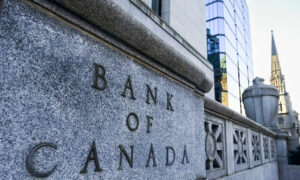
Financial system review examines vulnerabilities in banking sector due to higher interest rates
OTTAWA—Bank of Canada analysis shows that while global banking stresses have been contained and the Canadian banks remain robust, the effects of much higher interest rates are exposing vulnerabilities in the banking sector. These vulnerabilities can raise the cost of banks’ funding and thus make it harder for households and businesses to get loans, which could worsen a potential recession, according to the Bank of Canada’s annual financial system review (FSR), released May 18.
The BoC’s FSR identifies areas of concern in the economy that it is monitoring to see what could go wrong—and the related implications for the stability of the financial system.
Top of mind for the BoC are vulnerabilities that are getting exposed due to higher interest rates and business models that were predicated on an ongoing low-interest rate environment. This is the main difference from last year’s FSR, which focused primarily on housing-related concerns.
“It’s far too early to be thinking about interest rate cuts,” Bank of Canada Governor Tiff Macklem said in response to a question from The Epoch Times. “The message in this report is that we’re going through a transition to higher interest rates.”
The vulnerabilities include mismatches between assets and liabilities, large unrealized losses, and depositors with holdings greater than deposit insurance limits. A prime example is the end of Silicon Valley Bank.
“We don’t see those same sort of combination of features in those U.S. banks in our in our banking sector,” said senior deputy governor Carolyn Rogers.
Housing-related issues have long topped the list of the central bank’s areas of concern, but with the stresses in the banking sector in the United States and Switzerland that began in early March, the BoC led its FSR with a discussion about banking.
Reliance on Capital Markets
The BoC said “spillover effects in Canada from the recent stresses in the global banking sector have been limited.” But the concern identified is the banks’ capacity to provide credit to market participants as their funding costs mount, given the added volatility and higher costs of trading in financial markets.
One issue the BoC notes is that the big Canadian banks rely more on the capital markets or wholesale funding—issuing bonds and commercial paper—than the U.S. and European banks and that the capital markets are more susceptible to volatility due to stresses.
In addition, since mid-2022, deposits at Canadian banks have shifted from savings and chequing accounts into term deposits like guaranteed investment certificates, where the banks have to offer higher interest rates.
Canadian banks’ exposure to commercial real estate, an area of growing concern due to the decline in office space demand, is small at about 2 percent of total bank assets.
Housing
Canada has among the most highly indebted households in the world combined with overheated housing markets in Toronto and Vancouver.
The BoC said it “is more concerned than it was last year about the ability of households to service their debt.”
Households have less financial flexibility these days and the central bank says the share of households affected by higher rates will continue to rise as they renew their mortgages.
The BoC says that households become more vulnerable to defaulting if they experience a drop in income and this could lead to losses for banks, which leads to a type of vicious cycle where banks restrict how much they lend based on the credit losses they suffer, “potentially amplifying a recession.”
The Bank of Canada’s senior loan officer survey published May 12 showed that banks are the most restrictive they’ve ever been in the survey’s six-year history in mortgage lending.
Pricing of credit is the big driver of the tightening given the increase in mortgage rates, but to date, the central bank has not seen evidence of the terms of overall lending becoming more restrictive due to global banking stresses.
Ongoing areas of concern for the BoC include cyber threats to financial institutions, risks to asset prices from extreme weather events, and the uncertain transition to a low-carbon economy.
“Financial stability is a precondition for price stability,” Macklem said.

















































